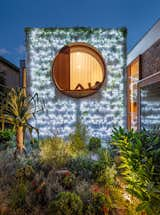Collection by linda l fiebranz
yard
In the remote mountains of Palmichal de Acosta, Costa Rica, local architect María de la Paz Alice, founder of Mazpazz Arquitectura, designed a 100 percent autonomous and self-sustaining home that frames its lush surroundings with a series of geometric openings. The home’s entrance, which the architect refers to as “the vortex,” takes the form of a poured-concrete cube with two prominent circular cutouts. Crystals encrusted in the floor capture and reflect light that passes from the sun and moon through the overhead oculus.
Architect Paul Elliott erected a new, cork- and timber-clad house on the adjoining plot to his family home, which his late architect father designed and built in Cape Town, South Africa. The new residence implements sustainable materials such as cork and timber. It also incorporates Japanese architectural styles, including circular windows and doorways.
Dubbed the Little Shingle for its unique exterior cladding—inspired by the homeowner’s college years spent in New England—the house is finished with Benjamin Moore’s Arborcoat stain in Decorator’s White. The awnings at both entrances are through Seattle Metal Products, powder-coated in pastel blue. A matching planter near the front door doubles as a handrail.
Sitting jauntily on its block, this renovated residence in Seattle’s Mount Baker neighborhood retained the original home’s footprint. The architect (and daughter of the homeowner) opened up the living spaces inside and overhauled the exterior and landscaping to give it a more contemporary presence. Cambium Landscape created the outdoor spaces which perfectly balance hardscape with greenery.
The couple took advantage of numerous municipal programs when landscaping the backyard. Mandy recently completed a free course through LADWP, who also promotes resources for the SoCal Turf Replacement Program, to become a certified California Native Plant Landscape: “There is an amazing amount of knowledge and resources for transitioning yards with more native/drought-tolerant plants through LADWP and the Theodore Payne Foundation,” says Mandy.
Recently retired and ready to downsize, Paul and Melonie Brophy found a lot in Palo Alto that gave them the chance to start fresh. Their glass, concrete, and wood house, designed by Feldman Architecture, seems to float above a landscape by Bernard Trainor. Of the board-formed concrete wall, architect Taisuke Ikegami says, "It connects the building to the ground plane while allowing the house to be a landscape element."
106 more saves



















